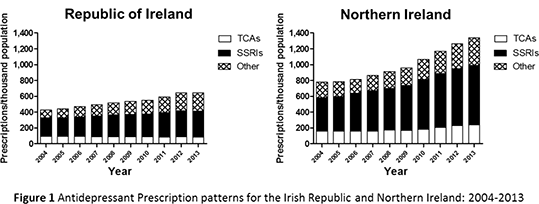| 170P London, UK Pharmacology 2016 |
Antidepressant prescription patterns in Ireland, 2004-2013: Is there a north/south divide?
Introduction: There has been an increasing incidence of antidepressant use in the western world. Ireland represents an interesting geographical area to study this phenomenon, encompassing two jurisdictions, the Republic of Ireland (ROI) and Northern Ireland (NI) that have differently organised health provision services. This study examined antidepressant prescribing patterns in Ireland over the 2004-2013 period.
Methods: The antidepressant prescribing data for 2004-2013 was obtained from the Health Service Executive (HSE) in the ROI or the Health and Social Care Northern Ireland (HSCNI). Antidepressants were classified into three groups, tricyclic antidepressants (TCAs), selective serotonin reuptake inhibitors (SSRIs) and “other” antidepressants. Results are expressed as the number of antidepressant prescriptions per thousand population.
Results: In 2004, the rate of antidepressant prescribing in the population in NI was approximately twice that of the ROI (Figure 1). By 2013, there had been a further 72% increase in prescribing in NI, compared to a 51% increase in the ROI. TCA prescribing in the ROI showed a 10% decline, whilst a 50% increase was seen in NI; in 2013 amitriptyline was responsible for 62% of TCA prescriptions in the ROI, and 81% in NI. Within the SSRI class, the major difference was the prescription of citalopram and escitalopram. In 2013, citalopram/escitalopram were responsible for 20%/44% of SSRI prescriptions in the ROI, whilst in NI it was 37%/8% of SSRI prescriptions. Prescription of the SSRI paroxetine declined in both jurisdictions, with an increase in sertraline prescribing, particularly in NI where there was a threefold increase. Over the study period, there was an increase in “other” antidepressant prescriptions, principally mirtazapine and duloxetine, whilst the ROI also saw a 60% increase in venlafaxine prescriptions.

Conclusion: Although we are unaware of any data suggesting higher rates of depressive disorders in NI compared to the ROI, a greater rate of antidepressant prescribing was consistently seen in NI; these rates are comparable to some other parts of the UK. A likely reason why TCAs continue to be used (despite greater concerns regarding their adverse effect profile) relate to their use for a wide range of conditions such as neuropathic pain and not just for treating depression. The greater prescribing of escitalopram in the ROI may suggest a marketing strategy for prescribing this agent or a greater belief in trial data demonstrating a superior (albeit small) effect of this agent.

